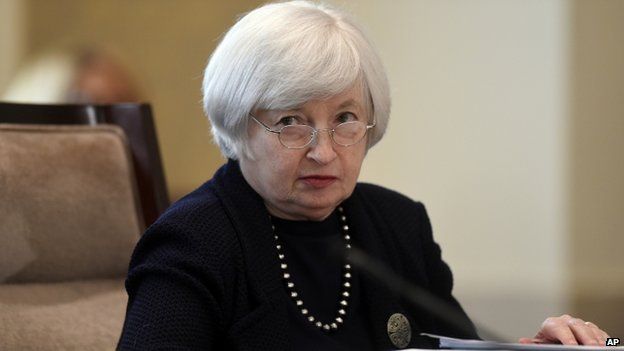Has quantitative easing helped the US economy?
- Published

Since the end of the financial crisis in 2008-2009, the US Federal Reserve has been, essentially, printing money to boost the US economy.
The programme, known as "quantitative easing" (QE), is about to come to an end in October.
At a press conference on Wednesday, US Fed chair Janet Yellen said QE was no longer necessary to support the US economy.
But a crucial question remains: has the programme worked?
While Ms Yellen may have her own opinions on the subject, the scholarly research into QE offers some insights into what has worked and what has not been effective.
Hasn't the Fed already had several attempts at QE?
First enacted by the Fed in the wake of the 2008-09 financial crisis, QE was basically what a central bank does when it runs out of its traditional arsenal of cutting interest rates and starts digging around in the bag for a new trick.
Frequently referred to as an "extraordinary stimulus" programme, at its most basic, QE is essentially when a central bank buys bonds to lower interest rates.
There were three rounds of quantitative easing. From late 2008 until 2010, the Fed bought nearly $2.1 trillion (£1.3tn) of treasury bonds and mortgage-backed securities. The programme was halted when the Fed signalled that it believed economic conditions had improved.
However, once the US economic recovery faltered later in the year, in November 2010 the Fed announced another round of QE. QE2 ended in the middle of 2011 after the Fed bought $600bn of bonds, primarily mortgage-backed securities.
Once more, however, the Fed was too optimistic. In late 2012, the Fed announced another round of open-ended bond buying, which eventually resulted in it buying $85bn per month. The Fed began "tapering" those purchases at the start of this year, and the programme is set to end in October.
Did it work?
In total, the Fed spent more than $4tn in its various rounds of bond buying. Most academics agree that the first round of printing money was a success - it was big enough, and lasted long enough, that it almost certainly prevented a more dire economic situation.
The jury is still out on the subsequent rounds of bond buying. One study found that QE2 was only a third as effective as the first round of QE.
Another paper, published by the San Francisco Federal Reserve Bank, found that QE2 added just 0.13 percentage points to the annual rate of economic growth in 2010, which was at 2.8% when the programme was implemented.
The authors of that paper argued that it was the Fed setting expectations about when rates would rise that gave people the confidence to invest, not printing money.
Were there any downsides?
Some experts have argued that the Fed has waited too long to announce an end to the current round of bond buying.
They point to the record highs of US markets, as well as increased borrowing in sectors such as subprime car loans, as an indication that low rates have encouraged speculative risk taking.
Andrew Huszar, a senior fellow at Rutgers Business School and former manager of the Fed's mortgage-buying programme, has argued that while rates may have been lowered, that didn't necessarily help ordinary Americans.
"QE may have been driving down the wholesale cost for banks to make loans, but Wall Street was pocketing most of the extra cash," he argued in the Wall Street Journal last November.
Did the Fed's policy choices affect anyone else?
Nearly every advanced economy in the world has discussed implementing some form of quantitative easing, with the UK and Japan already implementing QE measures and the European Union considering some similar policy.
Furthermore, printing money in the world's biggest economy also had an impact on global economies.
A recent paper from economists at the European Central Bank, examining the effects of QE1 and QE2 on 65 sovereign nations, found "there are indeed global spillovers and externalities from monetary policy decisions in advanced economies".
The paper found that while QE1 primarily led investors to pour money into the US, QE2 led investors to pour money into other, primarily emerging economies - and that has caused turmoil in those countries as the taps have started to be turned off.
What will the Fed do next?
While the Fed has been overly optimistic about bringing to an end previous rounds of QE - something that former Fed chair Ben Bernanke and current chair Janet Yellen have both admitted - it seems unlikely that another round of money printing will happen.
Now, there are two questions:
- When will the Fed finally raise its short-term interest rate, which has been stuck at near-zero since late 2008?
- How will the Fed "unwind", or get rid of, the billions of dollars of treasury bonds and mortgage-backed securities that it has purchased?
For now, these remain unanswered.